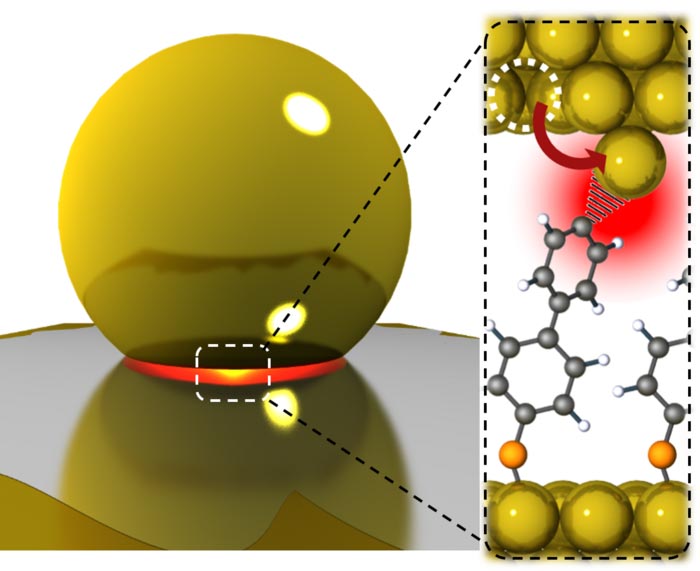Single-atom tractor beams power chemical catalysis

Single-atom tractor beams power chemical catalysis
Credit: Research Team, Cavendish Laboratory, Department of Physics, University of Cambridge
Unlocking possible new ways to make light act powerfully and drive chemical transformations.
By trapping light into tiny gaps only a few atoms wide, a team from the NanoPhotonics Centre has magnified optical forces a thousand-fold, strong enough to force atoms into positions that drive chemical reactions more efficiently.
“We found a new way to beef up the forces from light, enough to now move metal atoms, and that’s key to reduce the energy barrier for making catalysis work more easily” co-lead researcher Shu Hu explains.
Weak tractor beams are used to make optical tweezers that can probe biological processes with beams of tightly-focussed light that trap transparent micro-objects of glass or polymer. But to use light to pluck single atoms from solids requires much stronger forces. Now a team from the NanoPhotonics Centre in the Cavendish Laboratory has shown a way to build tiny crevices that magnify the optical forces of visible light. They use these to pull single gold atoms from a crystal, approach them close to a molecular bond, and watch the effects directly on their flopping and vibration. Published in Science Advances , they show new ways to make light act powerfully, and suggest new approaches for driving chemical transformations.
Watching one bond at a time in their experiments avoids averaging over a crowd of different effects. “Single metal atoms are the anvil where catalysis forges new chemical bonds” promises Prof Jeremy Baumberg, “and we can start to watch this process happening and control it”. Catalysis is instrumental for all manmade chemicals and polymers.
“It’s like watching the beautiful dance of an atom and a molecule in real time” notes Hu.
Reference: https://www.science.org/doi/10.1126/sciadv.abp9285
Jeremy J. Baumberg, Shu Hu et al. ‘ Optical suppression of energy barriers in single molecule-metal binding’ Science Advances. DOI: 10.1126/sciadv.abp9285
Media Contact
Pooja Pandey
University of Cambridge
pp550@cam.ac.uk
All latest news from the category: Life Sciences and Chemistry
Articles and reports from the Life Sciences and chemistry area deal with applied and basic research into modern biology, chemistry and human medicine.
Valuable information can be found on a range of life sciences fields including bacteriology, biochemistry, bionics, bioinformatics, biophysics, biotechnology, genetics, geobotany, human biology, marine biology, microbiology, molecular biology, cellular biology, zoology, bioinorganic chemistry, microchemistry and environmental chemistry.
Newest articles

Innovative 3D printed scaffolds offer new hope for bone healing
Researchers at the Institute for Bioengineering of Catalonia have developed novel 3D printed PLA-CaP scaffolds that promote blood vessel formation, ensuring better healing and regeneration of bone tissue. Bone is…

The surprising role of gut infection in Alzheimer’s disease
ASU- and Banner Alzheimer’s Institute-led study implicates link between a common virus and the disease, which travels from the gut to the brain and may be a target for antiviral…

Molecular gardening: New enzymes discovered for protein modification pruning
How deubiquitinases USP53 and USP54 cleave long polyubiquitin chains and how the former is linked to liver disease in children. Deubiquitinases (DUBs) are enzymes used by cells to trim protein…



